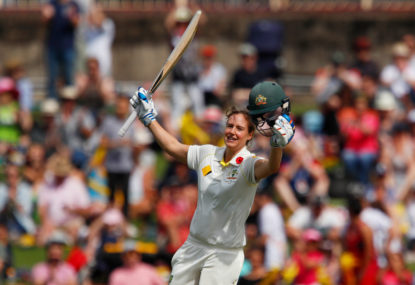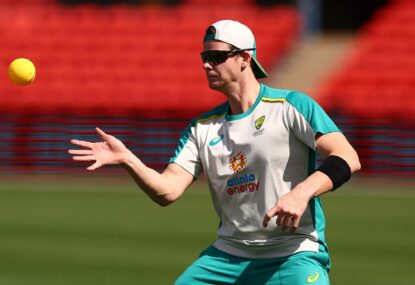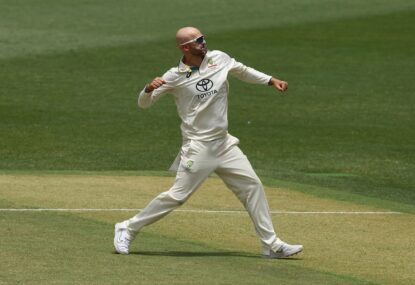The world is an espresso machine: there are knobs everywhere, and most of them are useless. But in 2017, the people knocking women’s sport have grown ever fewer and quieter.
Given the general cesspit that has been world politics this year, we end up sifting for glimmers of hope. One is seeing sport change across gender lines. There are still detractors who have a problem with other people’s enjoyment, but their pessimism looks silly next to concrete results.
More cricket
» Golden Ashes: Australia’s best partnerships
» Paine, Marsh, Bancroft in Ashes squad
» Ashes squad: every player analysed
» COMMENT: Paine’s selection is a farce
» COMMENT: Australia’s pace to rattle England
The AFLW’s first season packed out Princes Park and has clubs lining up to join. The Matildas dominated Brazil as Sam Kerr became a star. Serena Williams took out the Australian Open while pregnant, and cricket got over 27,000 people to the Lord’s final of the World Cup.
Four years previously, when I wrote about the 2013 World Cup for The Roar, no one was covering it. There were explosive stories. England accused Australia of throwing a pool match to block them from the final. In that final, Ellyse Perry pulled up lame before her first ball, then bowled ten overs on a broken foot to be player of the match.
After Australia’s win, I scrolled the sports websites of Australia’s newspapers and found nothing. Not worthy of mention.
Four years later, I was calling Australia’s World Cup games on ABC and BBC radio. We had teams of experts joining us on commentary. There were spreads in the papers and listeners in the hundreds of thousands. Selling out Lord’s was the remarkable culmination.
Last week in Sydney, England coach Mark Robinson said that the moment felt as significant when Perry made a Test double-century, scrambling there with her team nine wickets down, in front of a jubilant crowd.
“It reminded me of the day at Lord’s. It was a special day to have nearly 4000 there for a pink-ball Test match watching a player relentlessly go on to be excellent, and excellent, and excellent. I just thought it was brilliant. Hopefully it was another landmark day for women’s cricket.”
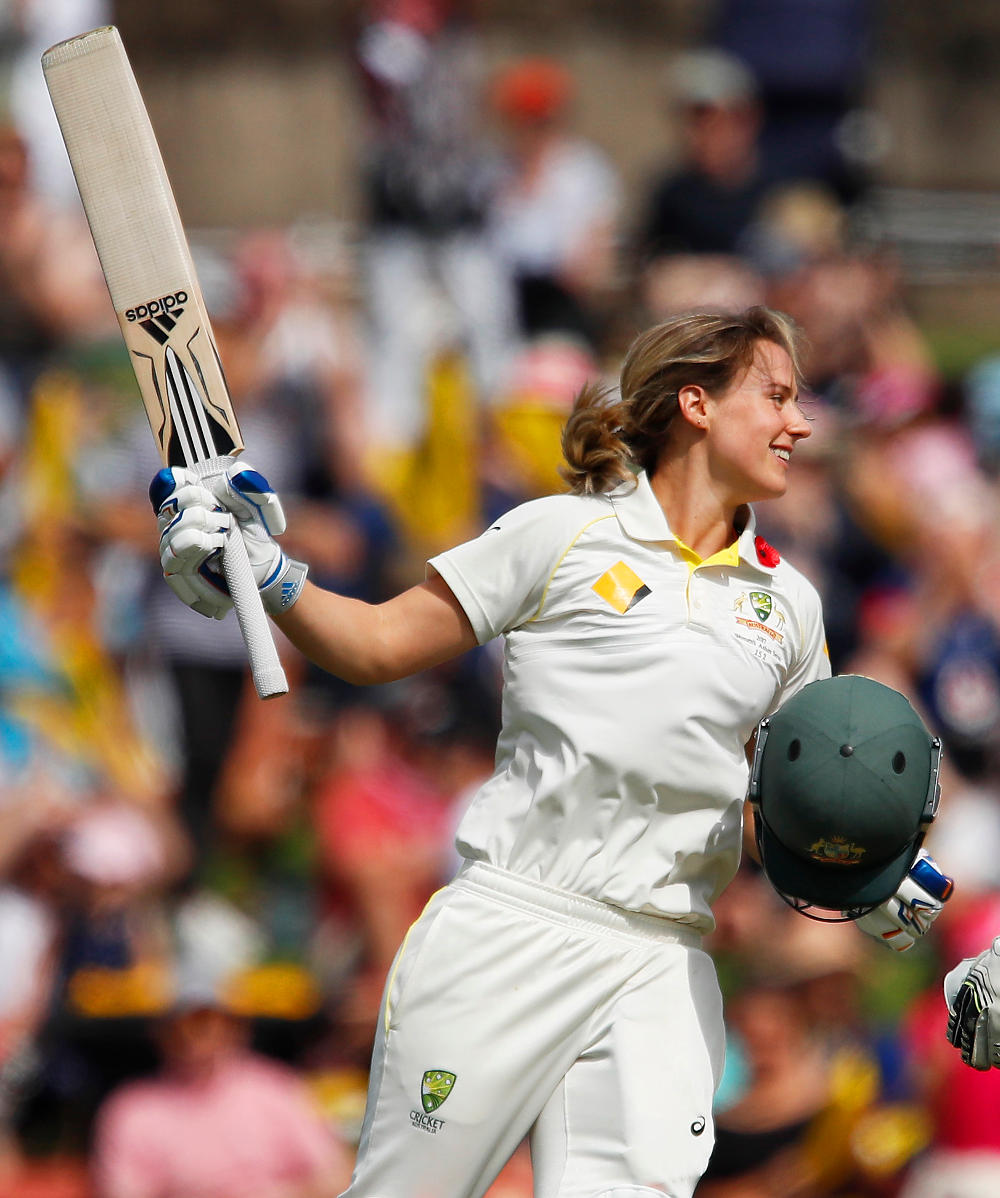
(AAP Image/Daniel Munoz)
Those numbers are significant for the format. Men’s Test cricket can be a hard enough sell at times. The women’s version doesn’t lack history – it dates back to 1934 – but has never had the profile, the player pool, or until the last couple of years, the professionalism.
Things started slowly on the first afternoon, a Thursday, but a good crowd came in by evening. The Friday night was better, Saturday better again. The grass banks around the eastern side had barely a space between sprawling bodies and picnic blankets.
There was a casual joyfulness. The sun slathered the ground later in the day, then drew back to set placidly behind the stands. A sky from eggshell blue to faded rose to gunmetal. That feeling of Australia’s end of year, summer starting to come in, the first hints of work barbeques and mince pies and Die Hard marathons.
It had cricket’s familiar types without the screaming drunkards. Groups of lads trying to work out how to impress each other. Chardonnay types in the corporate marquee. Couples getting pragmatically affectionate as the evening cooled. A few forward-looking types had brought doonas.
There was something beautiful about hearing classic fired-up fans in this format: “It’s come off her bat, you idiot,” echoed from the Thompson stand. The Richies came down too, a largely female group of them, playing the Wide World of Sports theme on trumpets and all the rest.
New South Wales players Ed Cowan and Sarah Aley chatted with Cricket Australia handyman Pat Howard on the hill. Mitchell Starc went to find Nathan Lyon while carrying two beers in each enormous hand.
Steve Smith was there, an Australian Test captain watching an Australian Test captain. He had his TV interview cut short because a wicket had fallen. There was a more important game in town.
Bevies of Sydney folk from sports bodies and media companies wandered in, not working but as punters. A full complement from The Roar’s Sydney office came down, not even at my suggestion. Telling was the presence of former Prime Minister John Howard, ever the populist.
For Sydney, it had become an official Thing To Do. It had seeped into the consciousness. The Betoota Advocate, finger on the pulse, ran an article headlined “Women’s Test Cricket Makes Stunning Debut On Office Man’s Laptop.”
Said its fictional subject: “I’ve suffered through the soap opera that is the f***ing men’s team for months now. This is a nice refreshing take on the game. Everybody looks like they’re having fun.”
The spectacle still has a way to go, as CA boss James Sutherland suggested while dampening the expectation of women’s Tests more than once in a blue moon.
He tempered “delight” at the crowd with the criticism that “there were 21 wickets for the game and the run-rate was relatively slow. There are probably a whole lot of conducive factors to that outcome.”
No, there were two. The pitch, and the preparedness of players. The wicket was rough and chewed up the pink ball while offering no bounce or spin. Neither discipline had the chance for dynamism. It almost guaranteed ending in a draw.
“The biggest disappointment was it wasn’t a fresh wicket, which I don’t get for this one-off Test match,” said Robinson amid more positive comments.
“They’ve got a young leg-spinner, she needs bounce. You’ve got Perry, Brunt, I take my hat off to Schutt, all of them ran in hard, didn’t they? Sometimes you want them to deserve better. We made such big strides as a women’s game and there’s one or two strides still to come.”
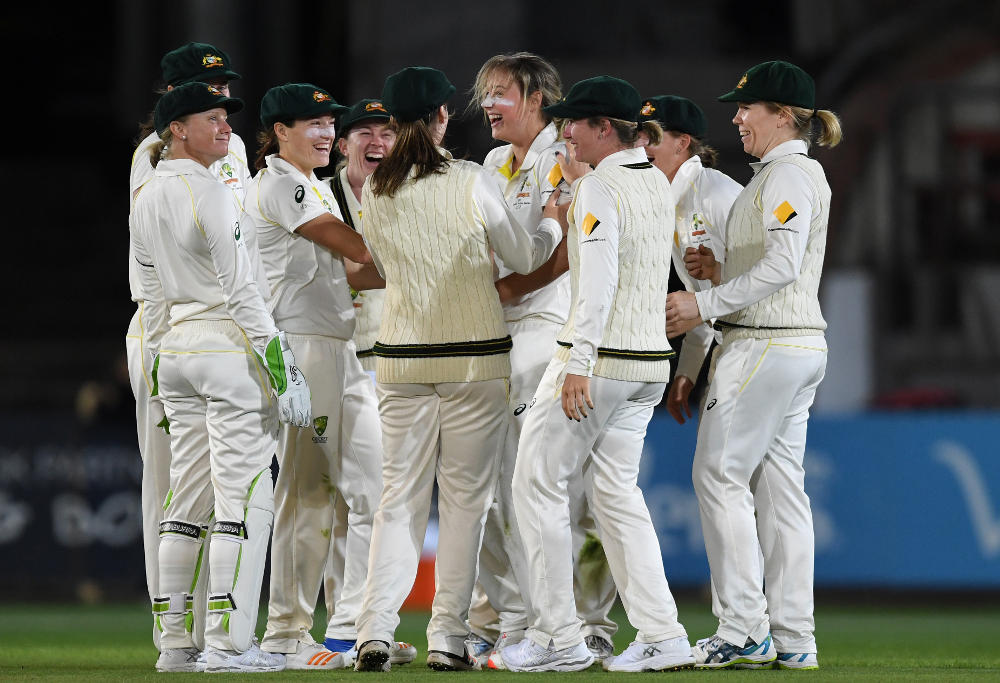
(AAP Image/Dean Lewins)
As for preparation, England and Australia currently play two Tests per four-year cycle. There are no multi-innings domestic games, no Tests with other nations. It is, if we’re honest, utterly freaking absurd.
And it makes it almost inevitable that women’s Tests will, at this stage in their development, be attritional. “It’s amazing what your mind does, when you come into this format of the game,” explained former England skipper Charlotte Edwards.
Players will be cautious with the bat, as you would if you got one chance every second year. Players will be limited with the ball, because defensive ODI bowling doesn’t work in Tests. This will only change with more games, more coaching, more development.
For all of that, the effort and adjustment on the fly was impressive. “I’ve done years and years of four-day cricket, but a lot of games like this where it’s actually in balance. Up to the mid-afternoon where we started to get into safer waters, quite a tense dressing room. It was a proper contest.”
And impressive the public response. Gender is no longer a decisive factor – this format has appeal. It’s just down to the bosses to change their tune. Something that went so well can’t be scheduled in Australia once every four years.
There are three T20s yet to come will decide the winner of the Women’s Ashes. But I would bet every dollar in the CA budget that none of them will be remembered as long.





























































































